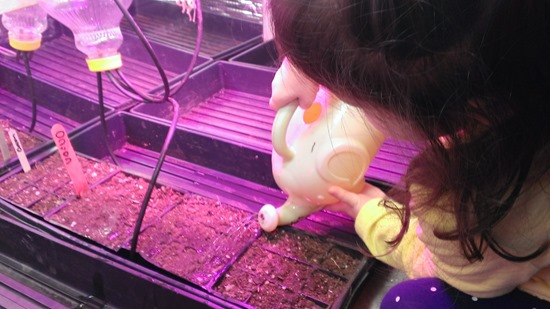When to start garden seeds indoors: Seed starting calculator
8.2 years ago cheap, indoor growbox, indoor seed starting, seedling, seeds

When you start seeds indoors in a vegetable garden, it can be difficult getting your schedule down to ensure that start your vegetable seeds with enough lead time that they are mature enough to venture outside but also not so large they take over your growing area.
Personally this has been a difficult part for me where I am really good getting the early vegetables started on time (onions, peppers, tomatoes) but when it comes to the later plants and/or second/third plantings is where I begin to get forgetful. Over the years I have come across a couple of great tools to make this easier that I thought I would share.
No matter which option you choose to start garden seeds indoors you will need to determine an important date, your last frost date. There are many sites/tables out there that will give an estimate I actually have a couple posts on the subject but at the moment my favorite site that makes this very easy is WeatherSpark, it uses historical data with great visuals to easily determine when the best probability of picking the right date. Here you can take a look at this historical data and make your call of what date you think will be safe.
1. Create a garden schedule. Just by figuring out your last frost date and doing a little math (Excel works great for this) you can determine the optimal seed starting dates and even get a general idea of when your plants should be ready for transplanting. What I love about this technique is you can tweak it each year as things worked well (or not so well) in previous years to get the schedule finely tuned to your particular garden and the micro-climates within it.
In addition knowing an estimate of when these plants will be venturing out in the wild can assist in your space planning for your seeding area as well as having a reality check if you see your peppers will be ready to be transplanted in March when it doesn’t get above freezing until mid-June.
Here is my schedule for starting seeds indoors my area and estimated last frost date (April 20th), though sure everyone that is reading this will not have the same date as mine so thanks to my infinite nerdiness I made the following table so you can adjust the “Last Frost Date” to yours and see how my schedule would look in your area.
| Last Frost Date: |
| Vegetable Name | Seed Start Date | Estimated Transplant Date |
Estimated Harvest Date |
| Celery | 1/19/2013 | 3/18/2013 | 4/24/2013 |
| Onion | 1/19/2013 | 3/25/2013 | 5/24/2013 |
| Leeks | 1/19/2013 | 3/21/2013 | 6/3/2013 |
| Kale | 1/26/2013 | 3/7/2013 | 3/22/2013 |
| Artichoke | 1/31/2013 | 4/27/2013 | 6/20/2013 |
| Kohlrabi | 2/9/2013 | 3/15/2013 | 4/5/2013 |
| Pak Choi | 2/9/2013 | 3/6/2013 | 4/10/2013 |
| Parsley | 2/8/2013 | 4/6/2013 | 4/24/2013 |
| Lettuce | 2/9/2013 | 3/6/2013 | 4/5/2013 |
| Broccoli | 2/9/2013 | 3/15/2013 | 4/20/2013 |
| Pepper – Jalapeno | 2/9/2013 | 4/28/2013 | 4/25/2013 |
| Pepper – Bell | 2/9/2013 | 5/4/2013 | 4/25/2013 |
| Swiss Chard | 2/16/2013 | 3/20/2013 | 4/7/2013 |
| Cabbage | 2/16/2013 | 3/31/2013 | 5/7/2013 |
| Brussel Sprouts | 2/22/2013 | 3/31/2013 | 5/23/2013 |
| Collards | 3/2/2013 | 3/24/2013 | 5/1/2013 |
| Tomato | 3/2/2013 | 5/4/2013 | 5/21/2013 |
| Spinach | 3/9/2013 | 4/23/2013 | |
| Peas | 3/9/2013 | 5/13/2013 | |
| Turnips | 3/9/2013 | 5/8/2013 | |
| Watermelon | 3/16/2013 | 5/27/2013 | 6/14/2013 |
| Basil | 3/24/2013 | 5/14/2013 | 6/22/2013 |
| Potatoes | 3/30/2013 | 7/8/2013 | |
| Radish | 3/31/2013 | 5/5/2013 | |
| Beets | 3/31/2013 | 6/4/2013 | |
| Carrots | 4/9/2013 | 6/23/2013 | |
| Corn | 4/9/2013 | 5/7/2013 | 6/28/2013 |
| Cucumber | 4/9/2013 | 5/16/2013 | 6/8/2013 |
| Okra | 4/9/2013 | 5/11/2013 | 6/13/2013 |
| Pumpkin | 4/9/2013 | 5/7/2013 | 7/28/2013 |
| Summer Squash – Sunburst | 4/9/2013 | 5/16/2013 | 6/3/2013 |
| Winter Squash – Hunter | 4/9/2013 | 5/16/2013 | 7/3/2013 |
| Zucchini | 4/9/2013 | 5/16/2013 | 6/3/2013 |
| Lettuce | 4/13/2013 | 6/7/2013 | |
| Beans | 5/4/2013 | 7/13/2013 | |
| Dill | 5/11/2013 | 7/15/2013 | |
| Carrots | 5/27/2013 | 8/10/2013 | |
| Broccoli | 6/22/2013 | 8/2/2013 | 8/31/2013 |
| Cabbage | 6/22/2013 | 8/2/2013 | 9/10/2013 |
| Kale | 6/22/2013 | 7/22/2013 | 8/16/2013 |
| Kohlrabi | 6/22/2013 | 7/29/2013 | 8/16/2013 |
| Cabbage – Napa | 7/24/2013 | 8/21/2013 | 10/7/2013 |
| Pak Choi | 7/24/2013 | 8/21/2013 | 9/22/2013 |
| Onion – Bunching | 7/24/2013 | 10/2/2013 | |
| Turnip | 7/24/2013 | 9/22/2013 | |
| Lettuce | 8/3/2013 | 9/27/2013 | |
| Spinach | 8/10/2013 | 9/24/2013 | |
| Corn Salad | 8/10/2013 | 9/29/2013 | |
| Garlic | 10/12/2013 | 2/14/2014 | |
| Pak Choi | 12/14/2013 | 1/26/2014 | 2/12/2014 |
* N/A because vegetables should be sown directly in the ground.
2. Create a garden plan online and get reminders. My favorite online vegetable gardening software is GrowVeg. It is very easy to use and provides some great visuals when to specifically plant seeds and transplant your seedlings outdoors, which you can see below.
In addition you also can recreate a virtual copy of your garden and plan exactly where you want to plant your vegetables, to ensure your ambitions for growing a huge crop this year does not exceed the reality of the limited space you have to actually grow. It also remembers where you planted vegetables in previous years to help enforce crop rotation to ensure pests/diseases will be forced to remain in check.
Though one of my favorite features is the weekly reminders, once a week you get a simple email letting you know what plants you should be starting/transplanting that week. This was very helpful later in the season where I probably would have completely forgotten about my carrots without this helpful reminder.
3. Buy a garden planning book. If you want something that you can really get your hands on you might want to check out the Week-by-Week Vegetable Gardener’s Handbook helps with this problem by providing weekly reminders of what vegetables you should be order/planting and what preparations you should be doing in your garden. This can be a very helpful tool in getting a little more organized in your vegetable garden.
Already falling behind on your seed planting here are a few great options to get a great selection of seeds without spending a lot of money:
- One of my favorites is Burpee Seeds, they have been around since 1876 and definitely know their stuff. The actually have a seed sale going on now where you get $15 off on order of $75 (just use code AFFB4A35) expires on 1/15
.
- The name is not too exciting but Generic Seeds
offers no thrills packaging with quality seeds and very reasonable prices and if you spend $20 or more shipping is on them.
Starting some onion seeds
9.3 years ago indoor growbox, indoor seed starting, onions, seeds
My three year old was really excited to start planting some seeds so we planted some red onions and put them in the grow box. This is a little ahead of my usual planting schedule but only by about a week.
Though the grow box does have automated watering my daughter insisted on watering them herself with her favorite yellow elephant watering can. If all goes well should have some decent sprouts by Valentines day. Plan on starting leeks next weekend and possible try growing celery for the first time this year.
What’s your garden plan this year?
New way to use egg cartons for starting seeds
10.2 years ago cheap, indoor seed starting, planter, seedling
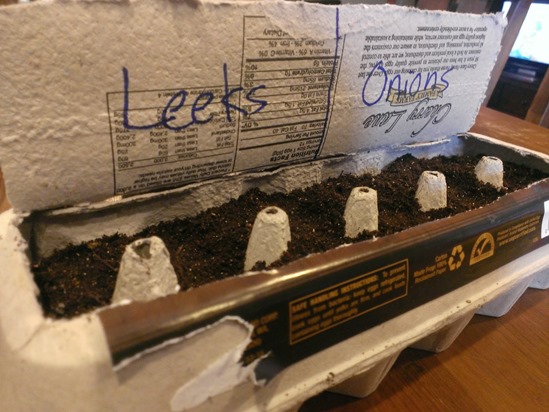
I have used egg cartons to plant seedlings before but here is a slight twist, instead of taking the whole lid off I cut the top off the lid. This not only gives you a neat place to label your seeds but more importantly, it provides an extra inch of depth for your seedlings to get a running start before being transplanted to your garden.
Planting seeds in January
10.3 years ago bok choy, indoor growbox, indoor seed starting, onions
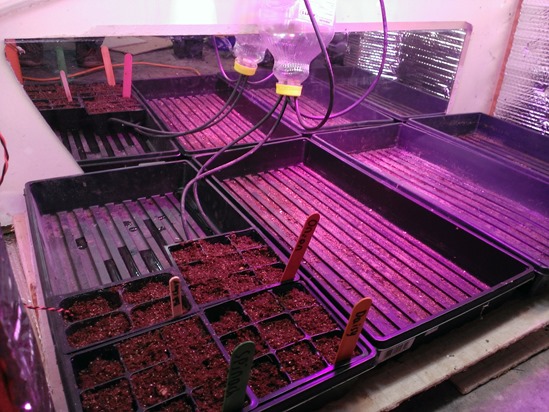
Though it is still pretty cold inside right now is the time for me to begin start planting seeds for this spring. These include bok choy which are very cold tolerant, onions which do pretty good in the cold but could use a head start on these to get some good sized bulbs by the end of the season. I also started some daisies which I will let mature plenty before bring them out. Finally I planted some spinach to try to grow some greens for consumption in my grow box given how much empty space I have in here right now 🙂
For my seed starting mix I start with some coconut coir, though you can find this in the gardening section I typically grab a three pack at the pet store at nearly half the price. Though looks like you can get it at a pretty good price on Amazon these days with free shipping.
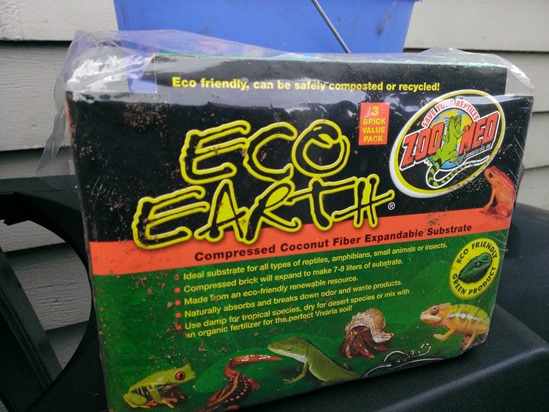
All you have to do is add 1 gallon of water and let sit for a about 10 minutes then still a bit with a trowel.
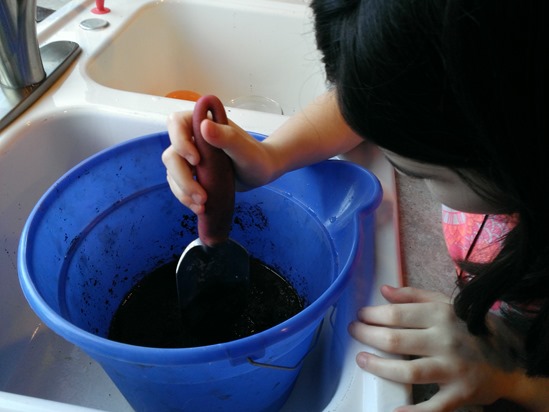
Though this works great by itself as a seed starting medium I typically add a couple cups of vermiculite (to lighten up and moisture control) and a handful organic fertilizer to add some trace minerals to give the seedlings a head start when they emerge.
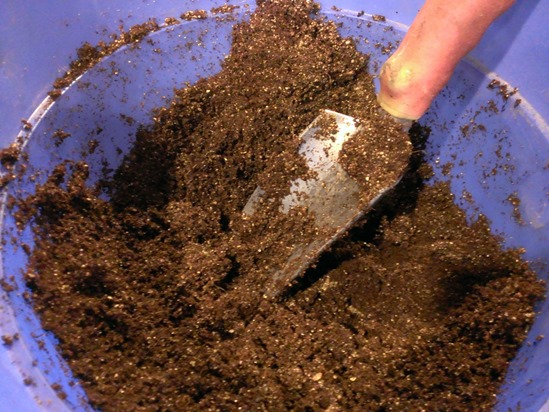
Finally will fill the Name Your Linkplant trays with your seedling mix and add you seeds, not watering should be required since the soil should already be pretty moist.
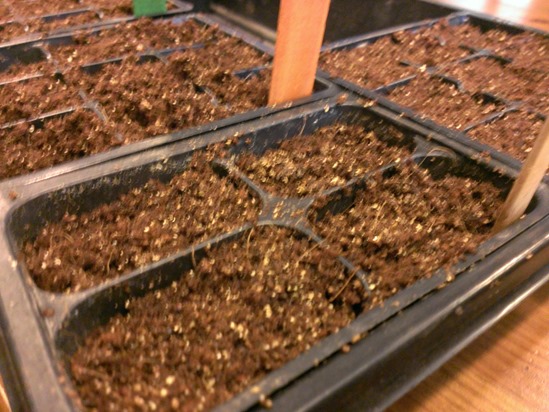
Complete by add some popsicle sticks with some handwritten labels or use a discarded yogurt container from your recycling container to make your own plant labels by simply cutting them into strips like shown below.
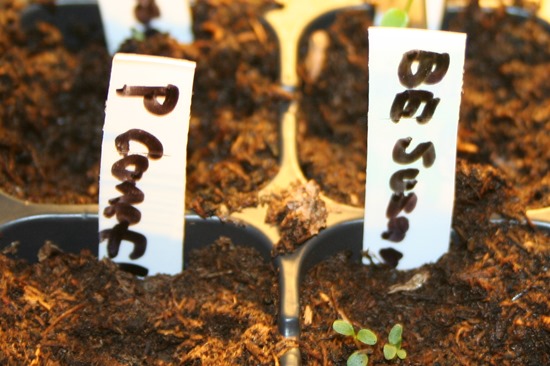
Growing vegetables from kitchen scraps
10.9 years ago guest post, indoor seed starting, vegetables
If you’re fond of gardening and you want to do something fun you can always use kitchen scraps to grow new vegetables. It’s not a difficult job, and you can ask your kids to help you. The activity can be extremely engaging, not to mention that you’ll have the chance to improve your kitchen’s overall décor.

Grow your own spring onions, fennel, leeks, and scallions
To plant the vegetables mentioned, you need the white roots. Your next step is to put the white roots in a pot and add some water, but pay attention because they shouldn’t be totally immersed in water. Put the pot on a window sill so that the sun can have access to it. In the next 3 to 5 days, you’ll see them grow. Take as much as you need and let the roots in the pot. Don’t forget to change the water once a week.
Lemongrass
The same applies to lemongrass, which means that all you have to do is put the roots in a pot, add water and place it near a sunny window. Note that lemongrass might need a little more sun than the vegetables mentioned above. After approximately seven days, you should see new growth. As soon as this happens, you have to move the plant into another pot, and add soil. Then, place it again near a sunny window.
Celery, Cabbage, Romaine Lettuce, and Bok Choy
You have to do the same as with the scallions. Remove the leaves, but not completely. Leave about one inch and face the white roots down; put them into a container and add water. Just like before, pay attention not to immerse the whole plant in water. These roots also need sun and constant fresh water. After a few days, you will notice that your plant will start sprouting, and in no more than 10 days, you will have to put it into soil. Obviously, the leaves must remain over the soil. In just a few weeks, you will have the possibility to harvest your produce. Lettuce, cabbage and celery will certainly compliment your kitchen’s décor, not to mention that they’re delicious.

Ginger
First of all, you have to know that growing Ginger is a really easy job. All you need is a chunk of Ginger that you will put in soil. Unlike the vegetables mentioned above, this one prefers filtered light. What is more, apart from using it in the kitchen, you can also utilize Ginger as a nice ornamental plant.
Potatoes
Everyone likes eating potatoes, especially children. So now you have the possibility to grow your own potatoes, whatever variety you prefer. The essential thing is for the scrap to feature those “eyes” growing on its surface. Every piece that you intend to use should have one or two eyes. Cut the vegetable into pieces, and let them in room temperature during the following days. Then, you have to plant them in a nutrient-rich soil. Hence, you need to add some compost into it prior to putting the potato cubs with their eyes up in the pot.
Garlic
To grow garlic you need just one clove. Put it in soil with the root facing down, and let the pot in a place that features warmth and sunlight. Then, the plant will grow and you will see how new shoots pop up. Once the plant is fixed into the soil, remove the shoots. After this, a new tasty garlic bulb will come out.

Mushrooms
If you want to grow mushrooms, make sure you do it in a pot and not in your garden, because otherwise, you will have a hard time trying to protect your mushrooms from other fungi. If you plant them in a pot, you will have the possibility to move them from one place to another in order to offer them the conditions they need. For example, you can try putting the mushrooms in a place that features warm filtered light throughout sunlight hours, and keep them in a place that features cool temperatures during nighttime. In order to grow mushrooms, you have to remove the head, and then put the stalk into a pot filled with soil. Note that the top of the stalk must remain at the surface.
Author Bio: Peter Smith wrote the awesome article. He is a part of site http://www.kitstone.co.uk/ where you can get a wide range of furniture collections. He is also a freelance writer who writes about everything fashion, health, home décor etc.
Growums seed gardening kit for kids review
11 years ago indoor seed starting, kids

I am a sucker for kids seed growing kits especially when I pass by them on clearance. The one I found was the Growums Herb Seed Kit at Lowes on clearance for $2.49, though typically they run for $5 so not a bad price at retail.
The kit includes 8 peat pots, bottom watering container to hold them, and ~20 seeds of basil, cilantro, oregano, parsley (each with matching labels for each peat pot with colorful characters on them.

It also came with a secret code that gives you access to an online site where the kids can watch for directions on how to start their plants and some additional advice on topics such as watering and pest control in short animated videos which had a bit of a Veggie Tales feel to them (minus the religious stories) The site also features a few garden related games for the kids to play.
Overall I like the design of the planter as it is very easy to setup basically place it on a sturdy container (cake/pie pan) and add a cup or so of water and watch the peat pots grow and plant 3 seeds in each pot and then water as needed and bring outdoors. I think the online portion is a nice touch to get your kids/grandkids dig a little more into the caring part of the plants versus planting some seeds and heading on their way. Given this uses standard sized peat pods you can easily use the planter again and again with the remaining seeds or any other variety you choose.
Along with the “herb garden” we got they also offer a “taco garden”, “salad garden”, “pizza garden”, “ratatouille garden”, and “stir-fry garden” which offers different selections of seed varieties associated with the theme.




